Mining Public Opinions on COVID-19 Vaccination: A Temporal Analysis to Support Combating Misinformation
Abstract
:1. Introduction
- Organizations have a rich information environment for decision-making, especially regarding people’s opinions present in online discussions on the social web;
- As a negative aspect of this rich environment, organizations have to deal with ungenuine information, in other words, with the dissemination of misinformation capable of affecting social welfare and causing impacts on people’s lives.
- To present the general composition of the corpora and general timeline according to the tweets collected.
- To test machine learning classification models and select the one with the best performance for multiclass classification tasks.
- To present the distribution of opinions on vaccination against COVID-19 on a timeline, identifying neutral, pro-, and anti-vaccination peaks.
- Based on a search in social web news channels, identify possible events causing the movements in opinions according to peak dates.
2. Methods
- (a)
- Data collection to assemble the corpora.
- (b)
- Text cleaning and preprocessing.
- (c)
- Training and testing the sentiment classification models (for instance, machine learning).
- (d)
- Best model selection.
- (e)
- Polarity annotation for each text in a corpus.
2.1. Initiation, Data Collection, and Preparation
2.2. Training and Testing Models
2.3. Classification and Annotation
2.4. Time Analysis
3. Results
3.1. Corpora Composition and Time Series
- One semester before the start of vaccination against COVID-19—the period from June to December 2020.
- The remaining eleven months run from January 2021, when the first vaccine against COVID-19 was applied in Brazil, until October.
3.2. Training and Testing Results
Models’ Performances
3.3. Distribution of the Classified Tweets over the Time
- 1st peak in a month interval which contains four events:
- Brazilian President’s online broadcast on COVID-19 awareness on 7 January.
- The first COVID-19 vaccine was applied in Brazil on 17 January.
- A speech by the Brazilian President about CoronaVac on 22 January.
- The Brazilian President confirmed that the government had approved the purchase of a COVID-19 vaccine by private companies on 25 January.
- 2nd peak in a month interval which contains three events:
- The law’s enactment authorized the federal government to join the Covax Facility on 2 March.
- The Brazilian President confirmed Pfizer’s vaccine purchase with the news that the first shots will arrive in April on 4 March.
- A presidential radio transmission announced that Brazil would be self-sufficient in producing COVID-19 vaccines on 23 March.
- The official televised launch of the COVID-19 National Vaccination Campaign on 16 December.
- A speech by the Brazilian President about the application of vaccines to the Brazilian population on 18 December.
- An online broadcast of the Brazilian President where he talked about COVID-19 and vaccination on 24 December.
- A speech by the Brazilian President about laboratories needing to register vaccines to sell to Brazil on 28 December.
- A deponent who allegedly lied received a prison order by the COVID’s Parliament Inquiry Commission on 7 July.
- The Brazilian President left the hospital after days of hospitalization, talking about the use of drugs against the COVID-19 on 18 July.
- The Brazilian President says the country will have a monthly record for distributing vaccines against COVID-19 on 22 May.
- The Brazilian President emphasizes vaccination and criticizes isolation in an official statement on 2 June.
Summary of the Events Search on News and Social Web According to the Opinion’s Polarity Timeline
4. Discussion
- Batra et al. [20] analyzed the sentiments expressed in tweets concerning COVID-19 vaccination in six countries: India, Pakistan, Norway, Sweden, Canada, and United States;
- Cotfas et al. [21] used a corpus of tweets in English to analyze public opinion about the COVID-19 vaccine in the United Kingdom;
- Luo et al. [55] used posts from Twitter and Sina Weibo to analyze public perceptions of COVID-19 vaccination in the United States and China;
- Alliheibi et al. [56] analyzed Saudi citizens’ opinions about vaccines.
Technical Difficulties and Challenges
- From the training process perspective, related to the first corpus with 143,615 tweets, we assumed the hypothesis that this number of texts ensured the reliability of the selected classification methods since, for this case, the sample was based on the number of textual components (or features) among uni-grams, bi-grams, and tri-grams.
- Especially for the hashtags’ sets presented in Table 1, for the first corpus construction, despite not being exhaustive, they were defined to ensure the retrieval of representative numbers of tweets for each pro, anti, and neutral part of the corpus, providing a training corpus also with significant numbers of considered features. Table 3 separates the initial numbers according to the polarities and the final number after a random cut for balancing the number of texts for each polarity class.
- For the second corpus, we assumed the hypothesis that the 221,884 tweets represented the maximum number existing for the 17 months to which the retrieval was applied, considering the constraints we imposed on the process. Note that we had parametrized the script to retrieve 1,500,000 results.
5. Final Considerations
5.1. Limitations
5.2. Further Research
Supplementary Materials
Author Contributions
Funding
Data Availability Statement
Acknowledgments
Conflicts of Interest
References
- Vagianos, D.; Zafiropoulos, K. An effective multidimensional model for analyzing Social Web Big Data—Testing in simple Web 2.0 applications of internet politics. IBIMA Bus. Rev. 2021, 2021, 589003. [Google Scholar] [CrossRef]
- Viola, C.; Toma, P.; Manta, F.; Benvenuto, M. The more you know, the better you act? Institutional communication in Covid-19 crisis management. Technol. Forecast. Soc. Change 2021, 170, 120929. [Google Scholar] [CrossRef] [PubMed]
- Li, J.; Li, X.; Zhu, B. User opinion classification in social media: A global consistency maximization approach. Inf. Manag. 2016, 53, 987–996. [Google Scholar] [CrossRef]
- Burnap, P.; Rana, O.F.; Avis, N.; Williams, M.; Housley, W.; Edwards, A.; Morgan, J.; Sloan, L. Detecting tension in online communities with computational Twitter analysis. Technol. Forecast. Soc. Change 2015, 95, 96–108. [Google Scholar] [CrossRef]
- Silva, R.M.; Santos, R.L.S.; Almeida, T.A.; Pardo, T.A.S. Towards automatically filtering fake news in Portuguese. Expert Syst. Appl. 2020, 146, 113199. [Google Scholar] [CrossRef]
- Murphy, J.; Vallières, F.; Bentall, R.P.; Shevlin, M.; McBride, O.; Hartman, T.K.; McKay, R.; Bennett, K.; Mason, L.; Gibson-Miller, J.; et al. Psychological characteristics associated with COVID-19 vaccine hesitancy and resistance in Ireland and the United Kingdom. Nat. Commun. 2021, 12, 29. [Google Scholar] [CrossRef] [PubMed]
- Nepomuceno, T.C.C.; Garcez, T.V.; Silva, L.C.; Coutinho, A.P. Measuring the mobility impact on the COVID-19 pandemic. Math. Biosci. Eng. 2022, 19, 7032–7054. [Google Scholar] [CrossRef]
- Reyna-castillo, M.; Santiago, A.; Martínez, S.I.; Antonio, J.; Rocha, C. Social Sustainability and Resilience in Supply Chains of Latin America on COVID-19 Times: Classification Using Evolutionary Fuzzy Knowledge. Mathematics 2022, 10, 2371. [Google Scholar] [CrossRef]
- Caldarelli, G.; De Nicola, R.; Petrocchi, M.; Pratelli, M.; Saracco, F. Flow of online misinformation during the peak of the COVID-19 pandemic in Italy. EPJ Data Sci. 2021, 10, 34. [Google Scholar] [CrossRef]
- Rao, H.R.; Vemprala, N.; Akello, P.; Valecha, R. Retweets of officials’ alarming vs reassuring messages during the COVID-19 pandemic: Implications for crisis management. Int. J. Inf. Manag. 2020, 55, 102187. [Google Scholar] [CrossRef]
- Biancovilli, P.; Makszin, L.; Jurberg, C. Misinformation on social networks during the novel coronavirus pandemic: A quali-quantitative case study of Brazil. BMC Public Health 2021, 21, 1200. [Google Scholar] [CrossRef] [PubMed]
- Bustos Díaz, J.; Nicolas-Sans, R. COVID-19 and Fake News. Encyclopedia 2021, 1, 1175–1181. [Google Scholar] [CrossRef]
- Moreira, M.R.C.; Cândido, J.A.B.; Alexandre, S.F.; Torres, G.M.C.; Dos Santos, C.M.B.; Costa, M.S. Categories of fake news about COVID-19 disseminated in the first year of the pandemic in Brazil. Mundo Saude 2021, 45, 221–232. [Google Scholar] [CrossRef]
- Silva, M.; Benevenuto, F. COVID-19 ads as political weapon. In Proceedings of the 36th Annual ACM Symposium on Applied Computing; ACM, Gwangju, Korea, 22–26 March 2021; pp. 1705–1710. [Google Scholar] [CrossRef]
- Galhardi, C.P.; Freire, N.P.; de Souza Minayo, M.C.; Fagundes, M.C.M. Fact or fake? An analysis of disinformation regarding the covid-19 pandemic in Brazil. Cienc. Saude Coletiva 2020, 25, 4201–4210. [Google Scholar] [CrossRef] [PubMed]
- Ricard, J.; Medeiros, J. Using Misinformation as a Political Weapon: Covid-19 and Bolsonaro in Brazil. Harvard Kennedy Sch. Misinformation Rev. 2020, 1, 1–8. [Google Scholar] [CrossRef]
- Li, Z.; Zhang, Q.; Du, X.; Ma, Y.; Wang, S. Social media rumor refutation effectiveness: Evaluation, modelling and enhancement. Inf. Process. Manag. 2021, 58, 102420. [Google Scholar] [CrossRef]
- Liu, J.; Liu, L.; Tu, Y.; Li, S.; Li, Z. Multi-stage Internet public opinion risk grading analysis of public health emergencies: An empirical study on Microblog in COVID-19. Inf. Process. Manag. 2022, 59, 102796. [Google Scholar] [CrossRef]
- Yoon, H.G.; Kim, H.; Kim, C.O.; Song, M. Opinion polarity detection in Twitter data combining shrinkage regression and topic modeling. J. Informetr. 2016, 10, 634–644. [Google Scholar] [CrossRef]
- Batra, R.; Imran, A.S.; Kastrati, Z.; Ghafoor, A.; Daudpota, S.M.; Shaikh, S. Evaluating polarity trend amidst the coronavirus crisis in peoples’ attitudes toward the vaccination drive. Sustainability 2021, 13, 5344. [Google Scholar] [CrossRef]
- Cotfas, L.-A.; Delcea, C.; Gherai, R. COVID-19 Vaccine Hesitancy in the Month Following the Start of the Vaccination Process. Int. J. Environ. Res. Public Health 2021, 18, 10438. [Google Scholar] [CrossRef]
- Cotfas, L.-A.; Delcea, C.; Gherai, R.; Roxin, I. Unmasking People’s Opinions behind Mask-Wearing during COVID-19 Pandemic—A Twitter Stance Analysis. Symmetry 2021, 13, 1995. [Google Scholar] [CrossRef]
- Monselise, M.; Chang, C.-H.; Ferreira, G.; Yang, R.; Yang, C.C. Topics and Sentiments of Public Concerns Regarding COVID-19 Vaccines: Social Media Trend Analysis. J. Med. Internet Res. 2021, 23, e30765. [Google Scholar] [CrossRef] [PubMed]
- de Carvalho, V.D.H.; Nepomuceno, T.C.C.; Costa, A.P.C.S. An Automated Corpus Annotation Experiment in Brazilian Portuguese for Sentiment Analysis in Public Security. In Lecture Notes in Business Information Processing; Springer: Cham, Switzerland, 2020; Volume 384 LNBIP, pp. 99–111. ISBN 9783030462239. [Google Scholar]
- de Carvalho, V.D.H.; Costa, A.P.C.S. Public Security Sentiment Analysis on Social Web: A Conceptual Framework for the Analytical Process and a Research Agenda. Int. J. Decis. Support Syst. Technol. 2020, 13, 1–20. [Google Scholar] [CrossRef]
- de Oliveira, W.C.C.; Reis, J.C.S.; Moro, F.B.M.M.; Almeida, V. Detecção de Posicionamento em Tweets sobre Política no Contexto Brasileiro. In Brazilian Workshop on Social Network Analysis and Mining (BraSNAM); Sociedade Brasileira de Computação—SBC: Natal, Brazil, 2018. [Google Scholar]
- de Carvalho, V.D.H.; Nepomuceno, T.C.C.; Poleto, T.; Turet, J.G. Ana Paula Cabral Seixas Costa Analyzing the Public Opinion Polarization about COVID-19 Vaccines in Brazil through Tweets. In Proceedings of the 2021 International Conference on Decision Support System Technology, Loughborough, UK, 26–28 May 2021. [Google Scholar]
- McKinney, W. Data structures for statistical computing in python. In Proceedings of the 9th Python in Science Conference (SciPy 2010), Austin, TX, USA, 28 June–3 July 2010; pp. 56–61. [Google Scholar]
- Honnibal, M.; Montani, I. spaCy 2: Natural Language Understanding with Bloom Embeddings, Convolutional Neural Networks and Incremental parsing. 2017. Available online: http://citebay.com/how-to-cite/spacy/ (accessed on 17 September 2022).
- Van Rossum, G.; Drake, F.L., Jr. Python Reference Manual; Department of Computer Science; Centrum voor Wiskunde en Informatica Amsterdam: Amsterdam, The Netherlands, 1995; Available online: http://citebay.com/how-to-cite/python/ (accessed on 17 September 2022).
- Pedregosa, F.; Varoquaux, G.; Gramfort, A.; Michel, V.; Thirion, B.; Grisel, O.; Blondel, M.; Prettenhofer, P.; Weiss, R.; Dubourg, V.; et al. Scikit-learn: Machine Learning in Python. J. Mach. Learn. Res. 2011, 12, 2825–2830. [Google Scholar]
- Alothman, B.; Rattadilok, P. Android botnet detection: An integrated source code mining approach. In Proceedings of the 12th International Conference for Internet Technology and Secured Transactions (ICITST), Cambridge, UK, 11–14 December 2017; pp. 111–115. [Google Scholar]
- Al-saif, H.; Al-dossari, H. Detecting and Classifying Crimes from Arabic Twitter Posts using Text Mining Techniques. Int. J. Adv. Comput. Sci. Appl. 2018, 9, 377–387. [Google Scholar] [CrossRef]
- Wagner, S.; Zimmermann, M.; Ntoutsi, E.; Spiliopoulou, M. Ageing-Based Multinomial Naive Bayes Classifiers over Opinionated Data Streams. In Lecture Notes in Computer Science (Including Subseries Lecture Notes in Artificial Intelligence and Lecture Notes in Bioinformatics); Springer: Cham, Switzerland, 2015; Volume 9284, pp. 401–416. ISBN 9783319235271. [Google Scholar]
- Hajek, P.; Henriques, R. Mining corporate annual reports for intelligent detection of financial statement fraud—A comparative study of machine learning methods. Knowl.-Based Syst. 2017, 128, 139–152. [Google Scholar] [CrossRef]
- Truică, C.-O.; Apostol, E.-S.; Șerban, M.-L.; Paschke, A. Topic-Based Document-Level Sentiment Analysis Using Contextual Cues. Mathematics 2021, 9, 2722. [Google Scholar] [CrossRef]
- Mitroi, M.; Truica, C.-O.; Apostol, E.; Florea, A.M. Sentiment Analysis using Topic-Document Embeddings. In Proceedings of the 2020 IEEE 16th International Conference on Intelligent Computer Communication and Processing (ICCP), Cluj-Napoca, Romania, 3–5 September 2020; pp. 75–82. [Google Scholar]
- Cichosz, P. A Case Study in Text Mining of Discussion Forum Posts: Classification with Bag of Words and Global Vectors. Int. J. Appl. Math. Comput. Sci. 2018, 28, 787–801. [Google Scholar] [CrossRef]
- Mostafa, L.; Beshir, S. Understating Factors Affecting Traveling During COVID-19 Using Sentiment Analysis Understating Factors Affecting Traveling During COVID-19 Using Sentiment Analysis; Springer International Publishing: Berlin/Heidelberg, Germany, 2022; ISBN 9783030897017. [Google Scholar]
- Li, Y.; Fleyeh, H. Twitter Sentiment Analysis of New IKEA Stores Using Machine Learning. In Proceedings of the 2018 International Conference on Computer and Applications (ICCA), Beirut, Lebanon, 25–26 August 2018; pp. 4–11. [Google Scholar]
- Matalon, Y.; Magdaci, O.; Almozlino, A.; Yamin, D. Using sentiment analysis to predict opinion inversion in Tweets of political communication. Sci. Rep. 2021, 11, 7250. [Google Scholar] [CrossRef]
- Rumi, S.K.; Deng, K.; Salim, F.D. Crime event prediction with dynamic features. EPJ Data Sci. 2018, 7, 43. [Google Scholar] [CrossRef] [Green Version]
- Breiman, L. Random Forests. Mach. Learn. 2001, 45, 5–32. [Google Scholar] [CrossRef]
- Gaye, B.; Zhang, D.; Wulamu, A. A tweet sentiment classification approach using a hybrid stacked ensemble technique. Information 2021, 12, 374. [Google Scholar] [CrossRef]
- Sharef, N.M.; Martin, T. Evolving fuzzy grammar for crime texts categorization. Appl. Soft Comput. 2015, 28, 175–187. [Google Scholar] [CrossRef]
- Thao, T.P.; Yamada, A.; Murakami, K.; Urakawa, J.; Sawaya, Y.; Kubota, A. Classification of Landing and Distribution Domains Using Whois’ Text Mining. In Proceedings of the Joint 16th IEEE International Conference on Trust, Security and Privacy in Computing and Communications, 11th IEEE International Conference on Big Data Science and Engineering and 14th IEEE International Conference on Embedded Software, Sydney, NSW, Australia, 1–4 August 2017; pp. 1–8. [Google Scholar]
- Nguyen Duc, M.; Ho Sy, A.; Nguyen Ngoc, T.; Hoang Thi, T.L. An Artificial Intelligence Approach Based on Multi-layer Perceptron Neural Network and Random Forest for Predicting Maximum Dry Density and Optimum Moisture Content of Soil Material in Quang Ninh Province, Vietnam. In Lecture Notes in Civil Engineering; Ha-Minh, C., Tang, A.M., Bui, T.Q., Vu, X.H., Huynh, D.V.K., Eds.; Springer: Singapore, 2022; Volume 203, pp. 1745–1754. ISBN 978-981-16-7159-3. [Google Scholar]
- Mendonça, A. Bolsonaro diz que Brasil é o 5o país que Mais Vacina; Veja os Gráficos; Estado de Minas: Belo Horizonte, Brazil, 2021. [Google Scholar]
- Satie, A. Brasil Ultrapassa 12 Milhões de casos de COVID-19; Média de Mortes Chega a 2.306; CNN Brasil: São Paulo, Brazil, 2021. [Google Scholar]
- Fernandes, A. COVID: Governo Bolsonaro Determina uso de Todas as Vacinas na 1a Dose; Estado de Minas: Belo Horizonte, Brazil, 2021. [Google Scholar]
- COVID-19: Projeto Torna Comprovante de Vacinação Obrigatório em Serviço Presencial; Agência Senado: Brasília, Brazil, 2021.
- Brasil Registra Menor Número de Casos de COVID em 24 Horas desde Janeiro; Média Móvel de Mortes é de 1.297; G1-Bem Estar: Rio de Janeiro, Brazil, 2021.
- Vacinação no Brasil: Mais de 115 Milhões de Doses de Vacinas Contra a COVID Foram Aplicadas; G1-Bem Estar: Rio de Janeiro, Brazil, 2021.
- Caetano, M.A.L. Political activity in social media induces forest fires in the Brazilian Amazon. Technol. Forecast. Soc. Change 2021, 167, 120676. [Google Scholar] [CrossRef]
- Luo, C.; Chen, A.; Cui, B.; Liao, W. Exploring public perceptions of the COVID-19 vaccine online from a cultural perspective: Semantic network analysis of two social media platforms in the United States and China. Telemat. Inform. 2021, 65, 101712. [Google Scholar] [CrossRef]
- Alliheibi, F.M.; Omar, A.; Al-Horais, N. Opinion Mining of Saudi Responses to COVID-19 Vaccines on Twitter: A Computational Linguistic Approach. Int. J. Adv. Comput. Sci. Appl. 2021, 12, 72–78. [Google Scholar] [CrossRef]
- Shorten, C.; Khoshgoftaar, T.M.; Furht, B. Deep Learning applications for COVID-19. J. Big Data 2021, 8, 18. [Google Scholar] [CrossRef]
- Zhang, Y.; Guo, B.; Ding, Y.; Liu, J.; Qiu, C.; Liu, S.; Yu, Z. Investigation of the determinants for misinformation correction effectiveness on social media during COVID-19 pandemic. Inf. Process. Manag. 2022, 59, 102935. [Google Scholar] [CrossRef]
- Pérez-Rosas, V.; Kleinberg, B.; Lefevre, A.; Mihalcea, R. Automatic detection of fake news. In Proceedings of the 27th International Conference on Computational Linguistics, Santa Fe, NM, USA, 20–26 August 2018; pp. 3391–3401. [Google Scholar]
- Lin, T.H.; Chang, M.C.; Chang, C.C.; Chou, Y.H. Government-sponsored disinformation and the severity of respiratory infection epidemics including COVID-19: A global analysis, 2001–2020. Soc. Sci. Med. 2022, 296, 114744. [Google Scholar] [CrossRef]
- Da Silva, B.M.; Ferreira, A.F.; da Silva, J.A.M.; de Amorim, R.G.; Domingues, A.L.C.; Pinheiro, M.C.C.; de Moraes Bezerra, F.S.; Heukelbach, J.; Ramos, A.N. Persistence of schistosomiasis-related morbidity in northeast brazil: An integrated spatio-temporal analysis. Trop. Med. Infect. Dis. 2021, 6, 193. [Google Scholar] [CrossRef]
- Cunha, N.S.P.; Fahrat, S.C.L.; de Olinda, R.A.; Braga, A.L.F.; Barbieri, C.L.A.; de Aguiar Pontes Pamplona, Y.; Martins, L.C. Spatial analysis of vaccine coverage on the first year of life in the northeast of Brazil. BMC Public Health 2022, 22, 1204. [Google Scholar] [CrossRef] [PubMed]
- Guo, Y.; Gao, J.; Sims, O.T. Associations between Bonus and Lottery COVID-19 Vaccine Incentive Policies and Increases in COVID-19 Vaccination Rates: A Social Epidemiologic Analysis. Trop. Med. Infect. Dis. 2022, 7, 118. [Google Scholar] [CrossRef] [PubMed]
- Cheng, I.K.; Heyl, J.; Lad, N.; Facini, G.; Grout, Z. Evaluation of Twitter data for an emerging crisis: An application to the first wave of COVID-19 in the UK. Sci. Rep. 2021, 11, 19009. [Google Scholar] [CrossRef] [PubMed]
- Dias, M.; Boné, J.; Ferreira, J.C.; Ribeiro, R.; Maia, R. Named Entity Recognition for Sensitive Data Discovery in Portuguese. Appl. Sci. 2020, 10, 2303. [Google Scholar] [CrossRef]
- Rangel, F.; Giachanou, A.; Ghanem, B.H.H.; Rosso, P. Overview of the 8th Author Profiling Task at PAN 2020: Profiling Fake News Spreaders on Twitter. CEUR Workshop Proc. 2020, 2696, 1–18. [Google Scholar]
- Jain, A.; Kasbe, A. Fake News Detection. In Proceedings of the 2018 IEEE International Students’ Conference on Electrical, Electronics and Computer Science (SCEECS), Bhopal, India, 24–25 February 2018. [Google Scholar] [CrossRef]
- Faustini, P.H.A.; Covões, T.F. Fake news detection in multiple platforms and languages. Expert Syst. Appl. 2020, 158, 113503. [Google Scholar] [CrossRef]
- Bhat, M.; Qadri, M.; Beg, N.-u.A.; Kundroo, M.; Ahanger, N.; Agarwal, B. Sentiment analysis of social media response on the Covid19 outbreak. Brain. Behav. Immun. 2020, 87, 136–137. [Google Scholar] [CrossRef]
- Melton, C.A.; Olusanya, O.A.; Ammar, N.; Shaban-Nejad, A. Public sentiment analysis and topic modeling regarding COVID-19 vaccines on the Reddit social media platform: A call to action for strengthening vaccine confidence. J. Infect. Public Health 2021, 14, 1505–1512. [Google Scholar] [CrossRef]
- Alamoodi, A.H.; Zaidan, B.B.; Al-Masawa, M.; Taresh, S.M.; Noman, S.; Ahmaro, I.Y.Y.; Garfan, S.; Chen, J.; Ahmed, M.A.; Zaidan, A.A.; et al. Multi-perspectives systematic review on the applications of sentiment analysis for vaccine hesitancy. Comput. Biol. Med. 2021, 139, 104957. [Google Scholar] [CrossRef]
- Agley, J.; Xiao, Y. Misinformation about COVID-19: Evidence for differential latent profiles and a strong association with trust in science. BMC Public Health 2021, 21, 89. [Google Scholar] [CrossRef]
- Abdulaziz, M.; Alotaibi, A.; Alsolamy, M.; Alabbas, A. Topic based Sentiment Analysis for COVID-19 Tweets. Int. J. Adv. Comput. Sci. Appl. 2021, 12, 626–636. [Google Scholar] [CrossRef]
- Vitório, D.; Souza, E.; Oliveira, A.L.I. Evaluating Active Learning Sampling Strategies for Opinion Mining in Brazilian Politics Corpora. In Progress in Artificial Intelligence; Moura Oliveira, P., Novais, P., Reis, L.P., Eds.; Lecture Notes in Computer Science; Springer International Publishing: Cham, Switzerland, 2019; Volume 11805, pp. 695–707. ISBN 978-3-030-30243-6. [Google Scholar]
- Babicki, M.; Malchrzak, W.; Hans-Wytrychowska, A.; Mastalerz-Migas, A. Impact of Vaccination on the Sense of Security, the Anxiety of COVID-19 and Quality of Life among Polish. A Nationwide Online Survey in Poland. Vaccines 2021, 9, 1444. [Google Scholar] [CrossRef]
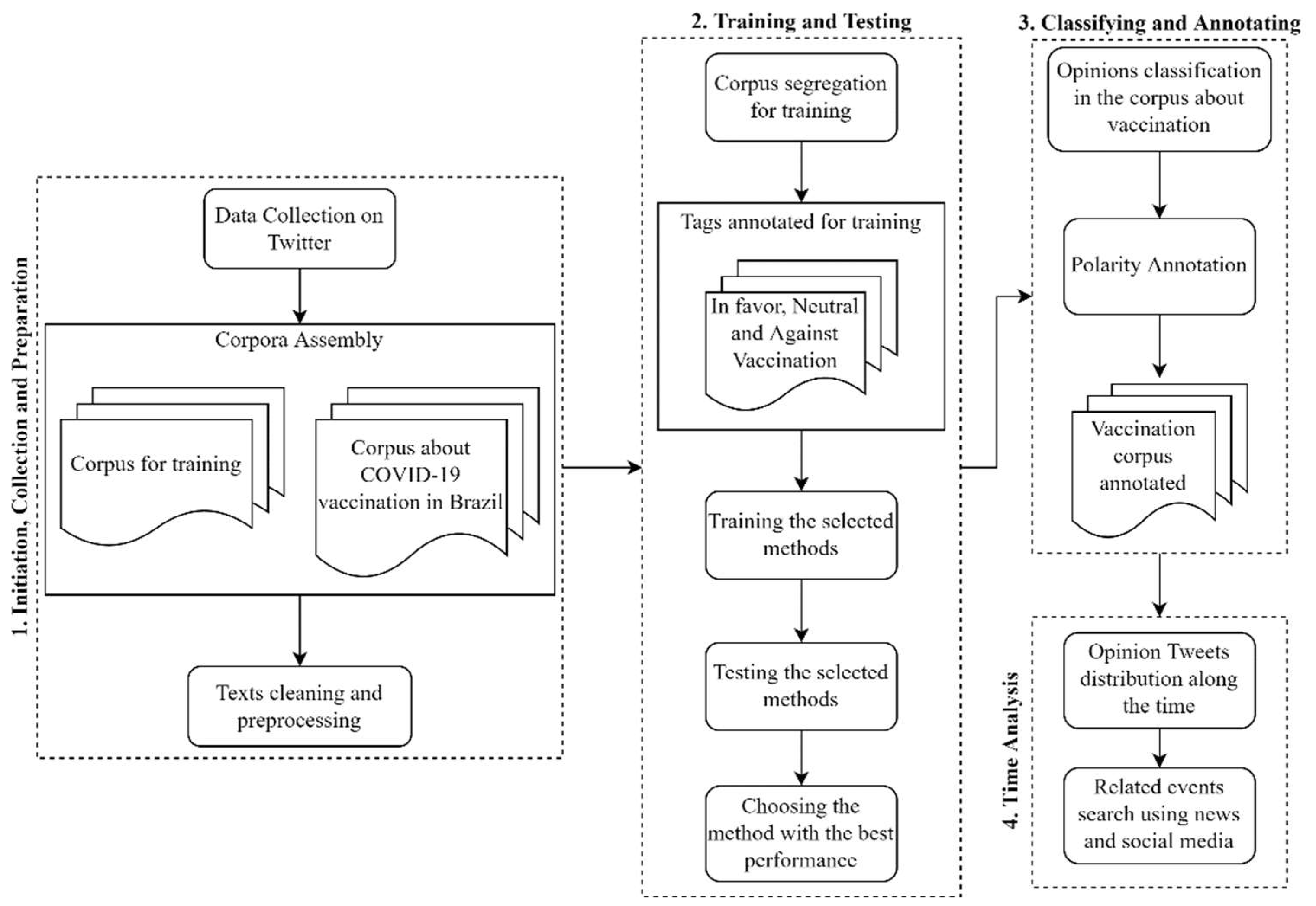
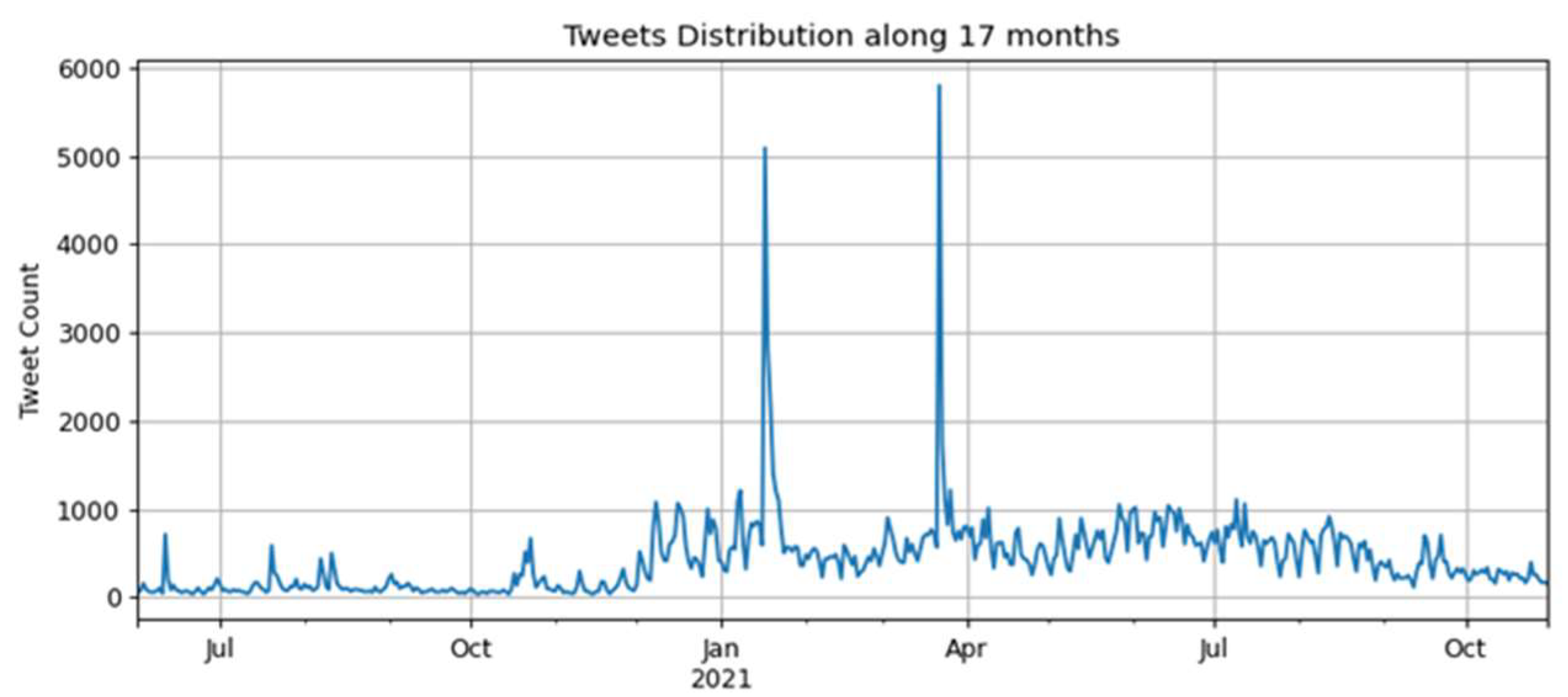

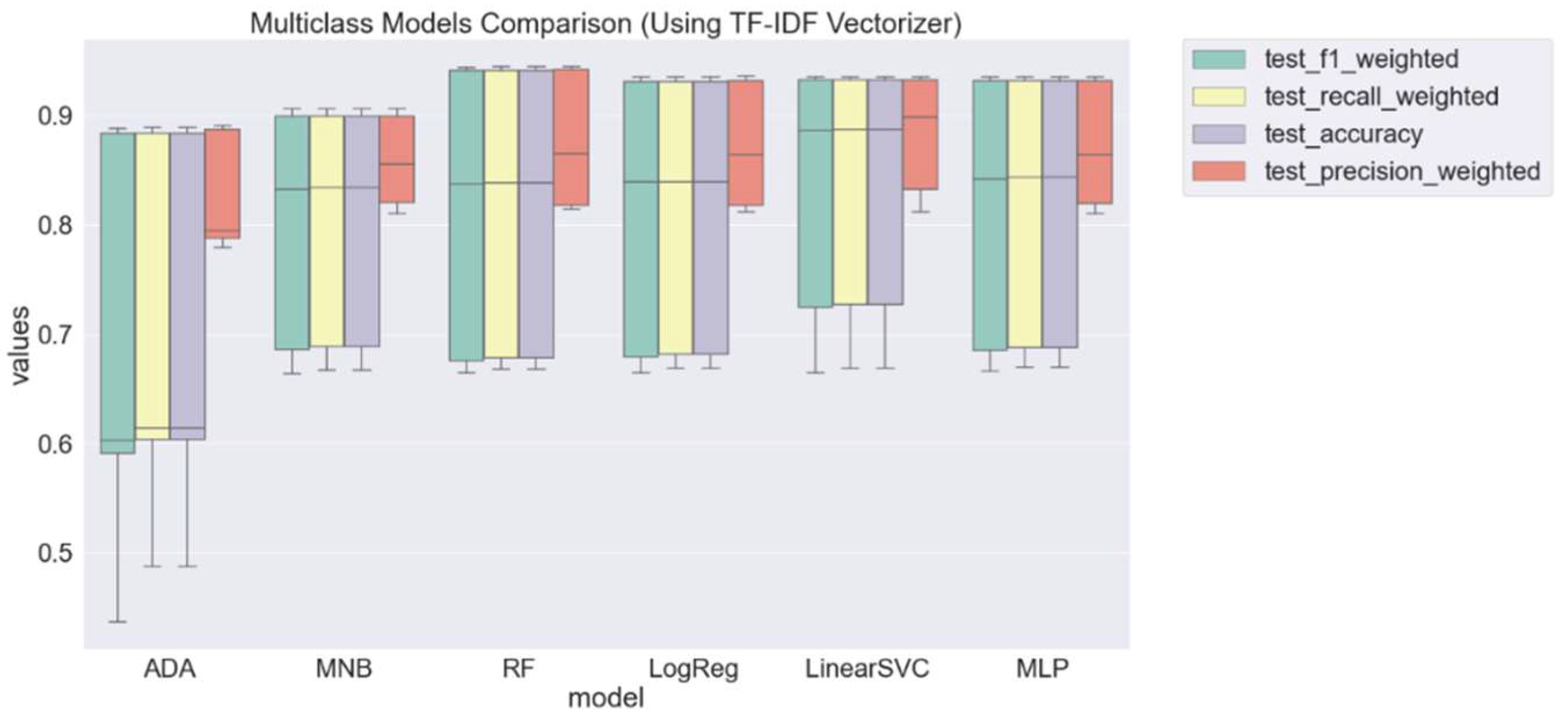

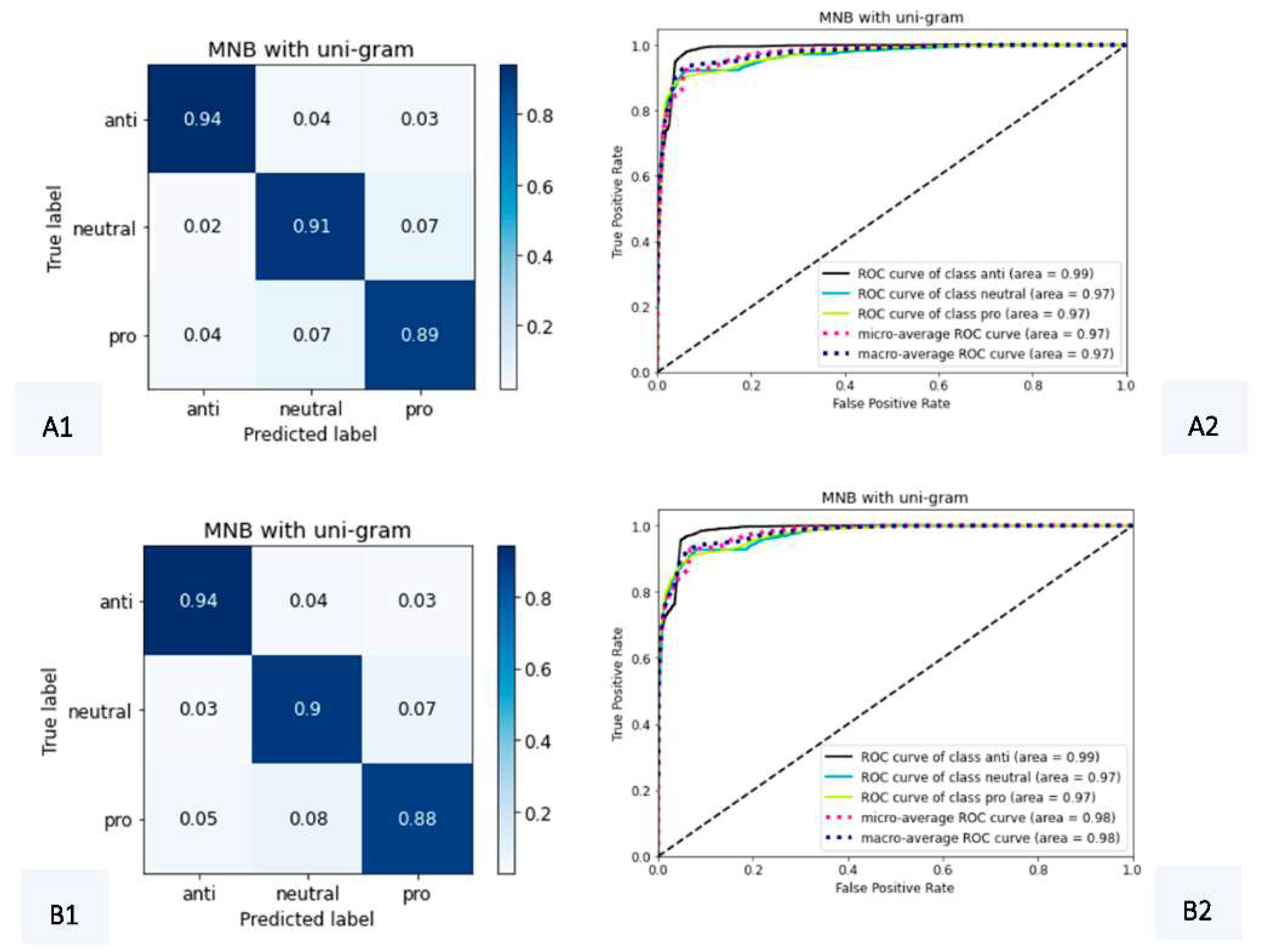

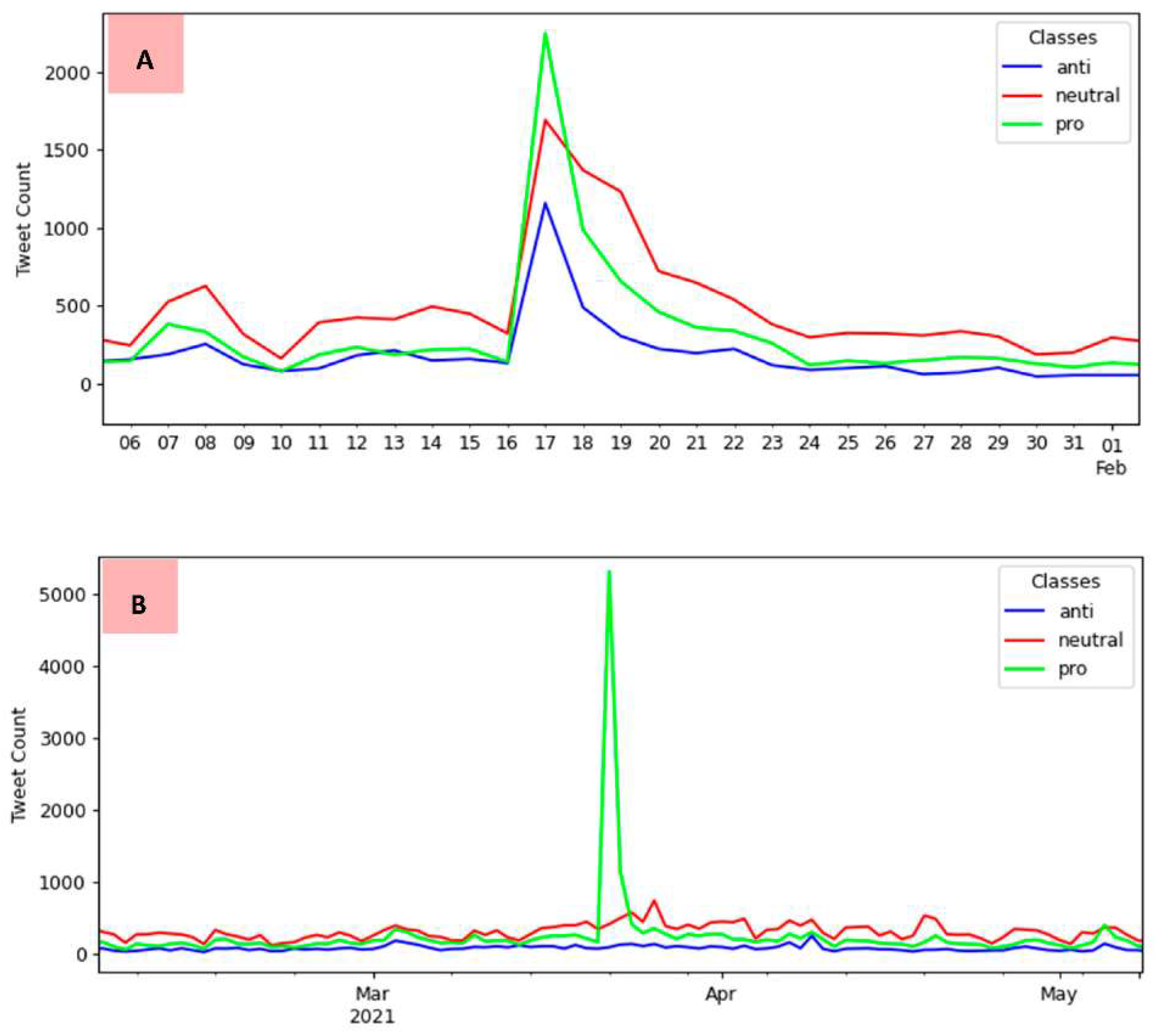
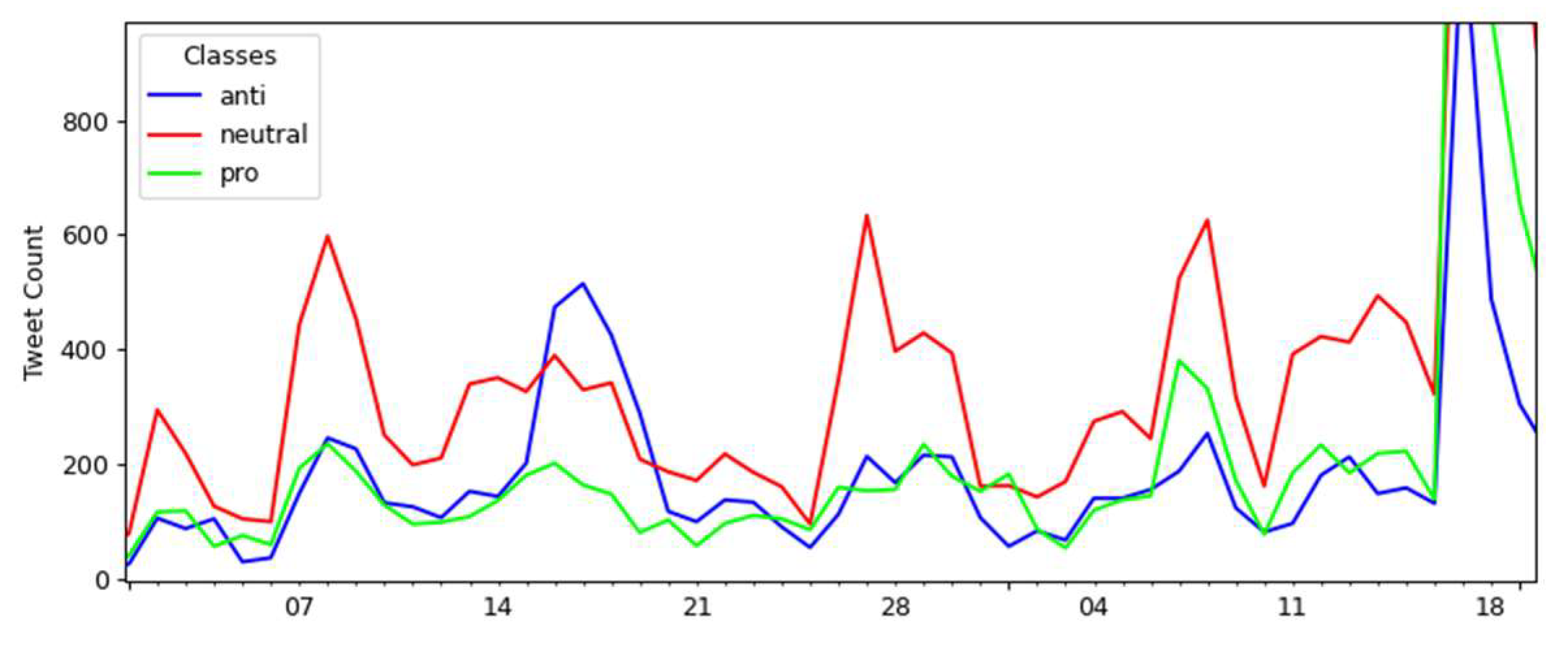
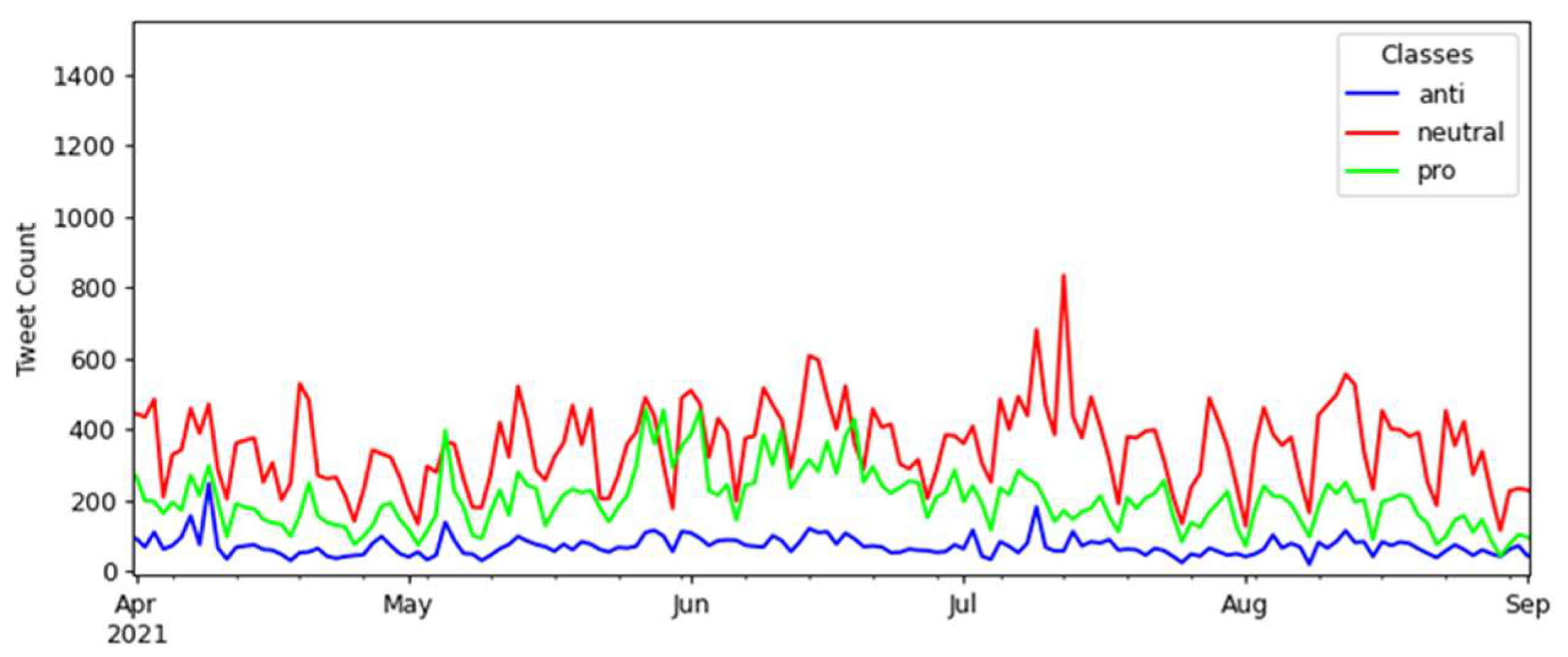
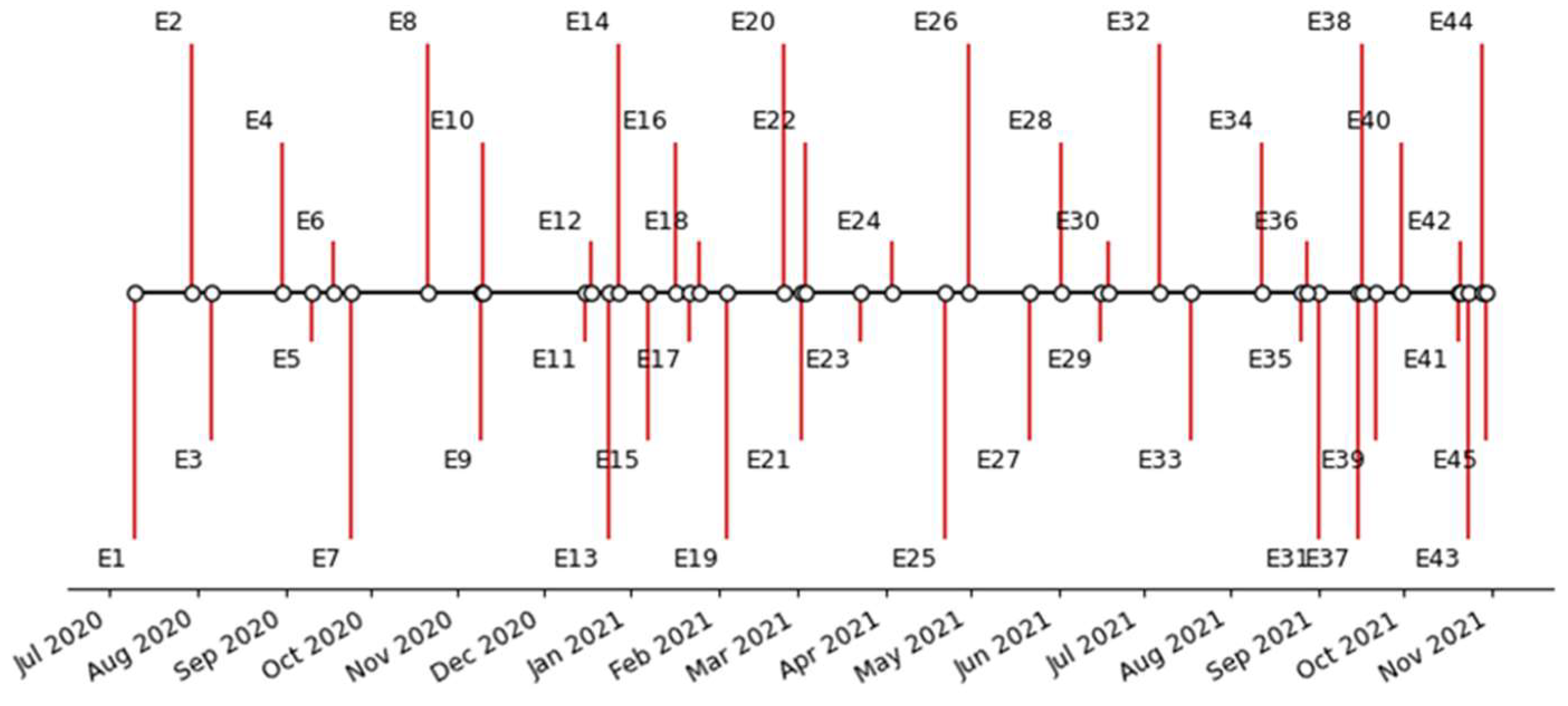
| Pro | Neutral | Anti |
|---|---|---|
| #vacinaja, #vacinaparatodos, #vacinabrasil, #vacinaurgenteparatodos, #vacinasim, #vemvacina, #vacinaprageral, #vacinaemgeral, #queremosvacina | #vacina, #vacinacao, #vacinacorona, #vacinacovid, #vacinacoronavirus, #vacinacovid19, #vacinacovid_19, #vacinacaocovid | #vacinanao, #eunaovoutomarvacina, #eunaosoucobaia, #naovousercobaia, #vacinaobrigatorianao, #naovoumevacinar |
| COVID and pandemic-related hashtags | #covid, #covid-19, #covid19, #covid_19, #coronavírus, #pandemia |
| COVID and pandemic-related free terms | covid, covid-19, covid19, covid_19, coronavirus, pandemia |
| Vaccination-related hashtags | #vacina, #vacinacao, #vacinacovid-19, #vacina_corona, #vacina_covid, #vacina_covid-19, #vacina_covid_19, #vacina_coronavirus, #vacina_covid19, #vacinacaocorona, #vacinacaocovid-19, #vacinacaocovid_19, #vacinacaocoronavirus, #vacinacao_corona, #vacinacaocovid19, #vacinacao_covid, #vacinacao_coronavirus, #vacinacao_covid19, #vacinacao_covid-19, #vacinacao_covid_19 |
| Vaccination-related free terms | vacina, vacinacao, vacinar, vacinado |
| Before Random Cut | After Random Cut | ||
|---|---|---|---|
| Tags | Count | Tags | Count |
| Pro | 49,477 | Pro | 16,498 |
| Anti | 44,643 | Anti | 16,498 |
| Neutral | 49,495 | Neutral | 16,498 |
| Total | 143,615 | Total | 49,494 |
| Tag | Count | % |
|---|---|---|
| Anti | 34,700 | 15.64 |
| Neutral | 118,645 | 53.47 |
| Pro | 68,539 | 30.89 |
| Total | 221,884 | 100.00 |
| Tweets’ Texts | Translation | Class |
|---|---|---|
| Que fique registrado que a primeira vacina de covid-19 no Brasil foi aplicada a contragosto do governo federal | Let it be noted that the first COVID-19 vaccine in Brazil was applied contrary to the federal government’s support | Neutral |
| Graças a Deus… Que está vacina seja abençoada na vida de cada ser humano!!! E continuemos com os cuidados… Viva a ciência e viva os institutos públicos. | Thanks to God… May this vaccine be blessed in the life of every human being!!! And let’s continue with the care… Long live science and long live public institutes. | Pro |
| Respeito o seu ponto de vista! Acho que é cedo para se tirar alguma conclusão sobre qualquer vacina. Mais essa Coronavac a procedência não me traz confiança afinal na China que essa pandemia começou! | I respect your point of view! I think it is too early to draw any conclusions about any vaccine. But the precedence of this Coronavac does not give me confidence, after all, it was in China that this pandemic started! | Anti |
| Tweets’ Texts | Translation | Class |
|---|---|---|
| A Secretaria de Saúde vacinou 1.502 idosos com a 1ª dose da vacina contra a covid-19 nesta segunda, 22. O município também aplicou a segunda dose do imunizante em 46 trabalhadores de saúde e 10 idosos. Desde o início da campanha, 30.795 pessoas foram vacinadas com a 1ª dose | The Health Department vaccinated 1502 older adults with the 1st shot of the COVID-19 vaccine on Monday, 22. The municipality also applied the second shot of the immunizing agent to 46 health workers and 10 older adults. Since the beginning of the campaign, 30,795 people have been vaccinated with the 1st shot | Neutral |
| Gratidão a Deus! Vacina agendada para paaaai. O coração transborda de emoção só pelo agendamento, imaginem quando ele se vacinar!!! | Gratitude to God! The vaccine is scheduled for my father. The heart overflows with emotion just by scheduling, imagine when he gets vaccinated!!! | Pro |
| Não ser obrigatória a vacina é respeitar os direitos individuais! Qdo chegar minha vez eu vou tomar a vacina, e tenho meu kit covid comprado. | Vaccination is not mandatory, it means respecting individual rights! When my turn comes, I will get the vaccine and have my covid kit purchased. | Anti |
Publisher’s Note: MDPI stays neutral with regard to jurisdictional claims in published maps and institutional affiliations. |
© 2022 by the authors. Licensee MDPI, Basel, Switzerland. This article is an open access article distributed under the terms and conditions of the Creative Commons Attribution (CC BY) license (https://creativecommons.org/licenses/by/4.0/).
Share and Cite
de Carvalho, V.D.H.; Nepomuceno, T.C.C.; Poleto, T.; Turet, J.G.; Costa, A.P.C.S. Mining Public Opinions on COVID-19 Vaccination: A Temporal Analysis to Support Combating Misinformation. Trop. Med. Infect. Dis. 2022, 7, 256. https://doi.org/10.3390/tropicalmed7100256
de Carvalho VDH, Nepomuceno TCC, Poleto T, Turet JG, Costa APCS. Mining Public Opinions on COVID-19 Vaccination: A Temporal Analysis to Support Combating Misinformation. Tropical Medicine and Infectious Disease. 2022; 7(10):256. https://doi.org/10.3390/tropicalmed7100256
Chicago/Turabian Stylede Carvalho, Victor Diogho Heuer, Thyago Celso Cavalcante Nepomuceno, Thiago Poleto, Jean Gomes Turet, and Ana Paula Cabral Seixas Costa. 2022. "Mining Public Opinions on COVID-19 Vaccination: A Temporal Analysis to Support Combating Misinformation" Tropical Medicine and Infectious Disease 7, no. 10: 256. https://doi.org/10.3390/tropicalmed7100256
APA Stylede Carvalho, V. D. H., Nepomuceno, T. C. C., Poleto, T., Turet, J. G., & Costa, A. P. C. S. (2022). Mining Public Opinions on COVID-19 Vaccination: A Temporal Analysis to Support Combating Misinformation. Tropical Medicine and Infectious Disease, 7(10), 256. https://doi.org/10.3390/tropicalmed7100256







